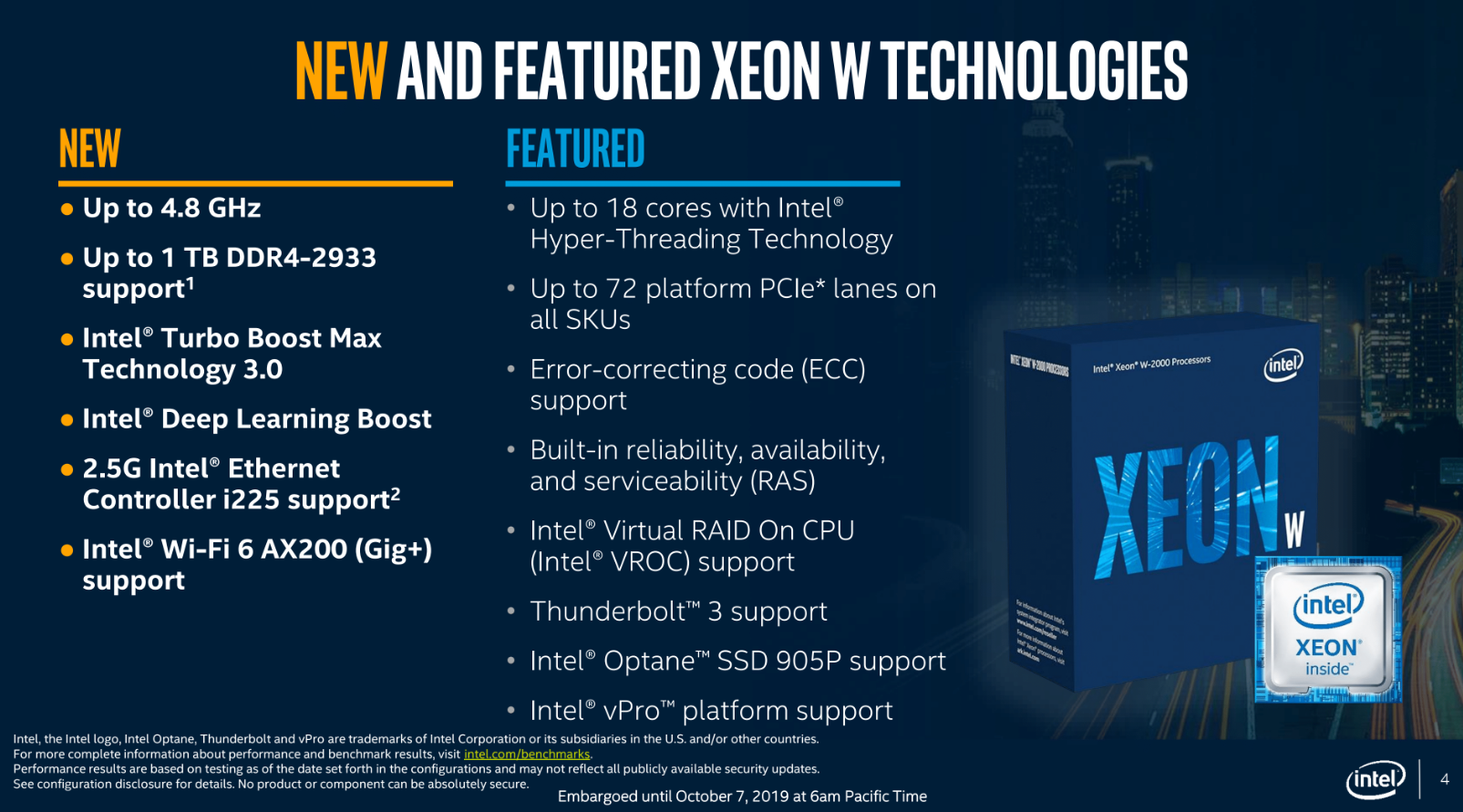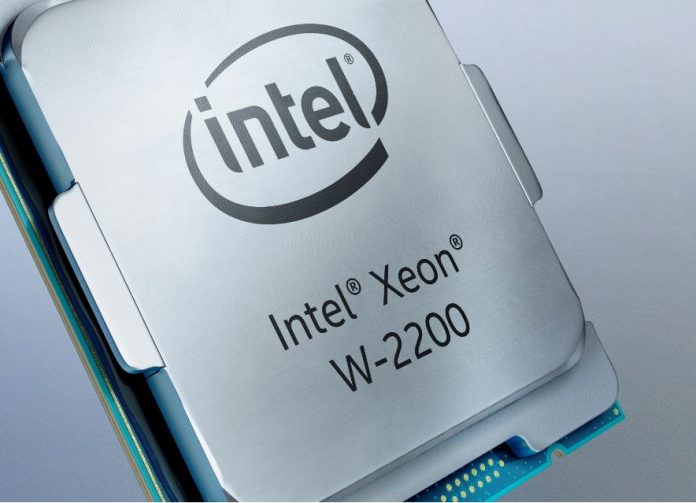The Intel Xeon W-2200 is designed to plug the gap between the Intel Xeon E-2200 Series and the Intel Xeon W-3200 series. We think it may succeed in that role. Most sites today are going to focus on the consumer Core i9 launch. Since we covered that last week in our New Intel Core i9 Platform Improvements and Dramatically Lower Costs piece, we are going to instead turn our attention to the new Intel Xeon W-2200 series.
Intel Xeon W-2200 Series Lineup
The Intel Xeon W-2200 Series features eight SKUs ranging from four cores to eighteen cores. All SKUs feature Hyper-Threading. They also support up to 1TB of memory and all handle DDR4-2933 ECC RDIMMs except for the Xeon W-2223 (DDR4-2666).

Intel does not have a 16 core part here that would put it into direct competition with the Xeon W-3245 ($1999.) One can see that pricing is higher than the Intel Core i9 Platform. One loses the ability to overclock, and pays a 40% premium at 18 cores, but can support 1TB of ECC memory.
If you compare pricing to the Xeon W-2100 series launched in 2017, you see that at the ~$1112 price range one goes from eight cores on the Xeon W-2145 to 14-cores on the new Xeon W-2275. Maintaining eight cores, at the same W2x45 SKU part one goes from $1113 to $667, for a 40% generation/ generation cost reduction.
Intel Xeon W-2200 Series Platform
We wanted to talk about some of the common technologies on the LGA2066 platform for this generation of CPUs.

The new chips at 8 cores and higher can hit up to 4.7-4.8GHz using Turbo Boost Max 3.0. All core turbos are in the 3.8GHz (Xeon W-2295) to 4.5GHz (W-2245) range. Since these chips use the new Cascade Lake IP, like the 2nd Gen Intel Xeon Scalable, there are features such as DL Boost (VNNI) support for AI inferencing. This will be important as we see more desktop applications take advantage of DL Boost as it becomes common in desktops.
On the memory side, there are four channels of DDR4-2933 (DDR4-2666 on the W-2223.) Frankly, Intel should have made them all DDR4-2933 support. It is almost like there is a product manager at Intel that distains having standardized feature sets. The differentiation point is that these CPUs can use ECC RDIMMs which means a 4x capacity boost over the desktop Core i9 variants along with higher reliability. We asked about Intel Optane DCPMM support, and Intel told us not on this platform.
The 2.5GbE Intel i225 and Wi-Fi 6 AX200 support are not built into the platform. Instead, those bullets refer to Intel saying it will work with its board partners to deliver those features.
Also, the 72 “Platform PCIe lanes” is a bit misleading. There are still 48x PCIe 3.0 lanes on the CPU. The PCH can support up to 24 PCIe lanes. If you want more PCIe lanes or PCIe bandwidth, you are still going to want dual Intel Xeon Scalable or AMD EPYC.
Comparing the Intel Xeon W-2200 Series to E-2200 and W-3200
Since the Xeon W-2200 line is the “middle child” of the Intel Xeon Workstation lineup, we wanted to show the Xeon E-2200 and Xeon W-3200 series that sits below and above it respectively in the stack.

Here is the Xeon W-2200 series:

Here is the W-3200 series:

You will notice that the Intel Xeon E-2286G will come under pressure from the Xeon W-2225. The Xeon W part sacrifices some top-end performance but has a higher base clock. The bigger reason is that the Xeon W has more memory channels, supports ECC RDIMMs for higher capacity, and has significantly more I/O. The Xeon W-2225 lacks an onboard GPU, but its lower purchase price can be used for a better GPU, such as the NVIDIA Titan RTX.
Also, chips below the Xeon W-3265 we see as being impacted heavily. The Xeon W-3200 series has more memory channels, but otherwise, users are likely better off with the 8-16 core parts of the Xeon W-2200 series due to pricing.
Final Words
Let us hope they make servers for the Xeon W-2200 series! Intel needs it in that market. Right now, the Xeon W-2200 series guts a lot of the value proposition from the lower-end Xeon W-3200 series. Intel is responding to competitive pressures and lowering prices. The older Xeon W-2100 series is completely obsolete as a result.
For a workstation, these look like promising parts from Intel. At the same time, the trade for ECC memory versus overclocking was not a simple swap. The new core i9 series is substantially less expensive. This is a departure from the Xeon E-2xxx series and E3-1200 series and the Core i7 models where at around the same price one loses overclocking but gains ECC support. Since Intel decided not to do that, our readers will need to take a critical look at whether they need ECC memory. If not, the Core i9-109xx parts are a better value.





“notice that the Intel Xeon E-2286G will come under pressure from the Xeon W-2225”
I think you may have meant the Xeon W-2245 not the W-2225. The Xeon W-2225 has half the number of CPUs and half the amount of cache as the Xeon E-2286G. But even so, I’m not sure I agree.
Xeon W-2245 $667
Xeon E-2286G $527 (right now)
Is that $140 difference really worth more memory bandwidth, a few more PCI-E lanes and slightly higher base clock? Maybe for some I’m sure but I’m not seeing the value there, especially if you rely on quick sync too.
I wonder if real world tests would show much of a difference between the two.
Nevermind on the above. I was trying to compare the Xeon W-2245 with the Xeon E-2288G.
Interestingly, all of the existing Xeon-W LGA2066 motherboards I’ve seen can only handle CPUs up to 140W TDP. That means they can only handle the Xeon W-2200 line up to 6 cores.
It should be interesting to see if the existing boards get re-qualified or if new ones need to be designed and manufactured.
I could only hope people continue to buy AMD. Even after 50% reduction, which sounds a lot at first, is still $600 for 8 Core Xeon CPU. Hopefully Apple wont paid anywhere near that price for their iMac Pro.
They still didn’t get that you can’t just strip something like ECC for segmentation. Why?